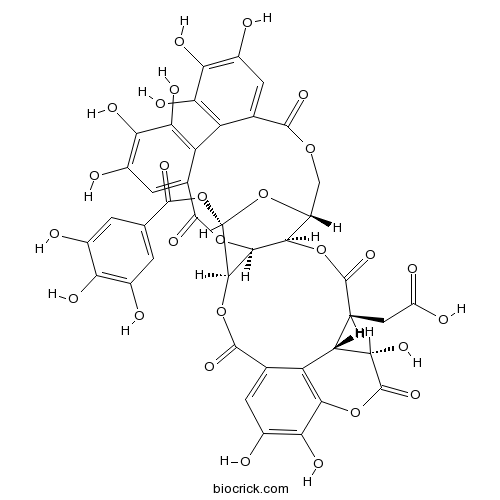InChI=1S/C41H30O27/c42-13-1-8(2-14(43)24(13)49)35(56)68-41-34-33-31(64-39(60)12(6-19(47)48)22-23-11(38(59)67-34)5-17(46)27(52)32(23)65-40(61)30(22)55)18(63-41)7-62-36(57)9-3-15(44)25(50)28(53)20(9)21-10(37(58)66-33)4-16(45)26(51)29(21)54/h1-5,12,18,22,30-31,33-34,41-46,49-55H,6-7H2,(H,47,48)/t12-,18+,22-,30-,31+,33-,34+,41-/m0/s1
Chebulagic acid, isolated from the fruits of Terminalia, it shows potent COX–LOX dual inhibition activity with IC50 values of 15 ± 0.288, 0.92 ± 0.011 and 2.1 ± 0.057 μM for COX-1, COX-2 and 5-LOX respectively, it also shows anti-proliferative activity against HCT-15, COLO-205, MDA-MB-231, DU-145 and K562 cell lines, it induces apoptosis in COLO-205 cell line.[1]
Chebulagic acid significantly suppresses the onset and progression of arthritis (CIA) in mice, immune suppression via the induction of TGFbeta and CD4+,CD25+ T cells may represent a new strategy in the development of therapies for managing rheumatoid arthritis and other inflammatory diseases.[2]
Chebulagic acid , a natural anti-oxidant, shows potent anti-inflammatory effects by suppressing NF-κB and MAPK activation in LPS-stimulated RAW 264.7, a mouse macrophage cell line. [3]
Chebulagic acid can reduce the viral cytopathic effect on rhabdomyosarcoma cells with an IC50 of 12.5 ug/mL, the utilization of the chebulagic acid treatment on mice challenged with a lethal dose of enterovirus 71 is able to efficiently reduce mortality and relieve clinical symptoms through the inhibition of viral replication, suggests that chebulagic acid may represent a potential therapeutic agent to control infections to enterovirus 71.[4]
Chebulagic acid and punicalagin have broad-spectrum antiviral activity against viruses that use glycosaminoglycans for entry.[5]
Chebulagic Acid is a potent α-glucosidase inhibitor, has anti-hyperglycemic effect .[6,7]
Chebulagic acid has neuroprotective effect via autophagy induction in SH-SY5Y cells.[8]
English website: Chebulagic acid
Japanese website: Chebulagic acid
Chinese website: Chebulagic acid
[1] Reddy D B, Reddy T C M, Jyotsna G, et al. J Ethnopharmacol, 2009, 124(3):506-12.
[2] Sang-Ik Lee †, Hyun P M, Kim S H, et al. Arthritis & Rheumatol, 2005, 52(1):345-53.
[3] Reddy D B, Reddanna P. Biochem Bioph Res Co, 2009, 381(1):112-7.
[4] Yang Y, Xiu J, Liu J, et al. Int J Mol Sci, 2013, 14(5):9618-27.
[5] Lin L T, Chen T Y, Lin S C, et al. Bmc Microbiol, 2013, 13(1): 187-91.
[6] Huang Y N, Zhao D D, Gao B, et al. Int J Mol Sci, 2012, 13(5):6320-33.
[7] Gao H, Huang Y N, Gao B, et al. Biosci Biotech Bioch, 2008, 72(2):601-3.
[8] Kim H J, Kim J, Kang K S, et al. Biomol Ther, 2014, 22(4):275-81.
[9] Nie G H, Li Z G, Lv Y Q, et al.Chinese Pharmaceutical Journal, 2001, 36 (8): 517-9.



